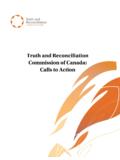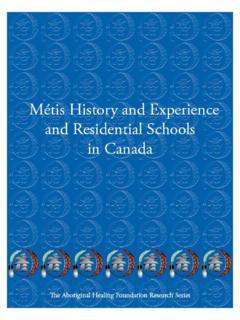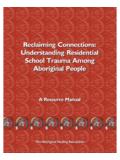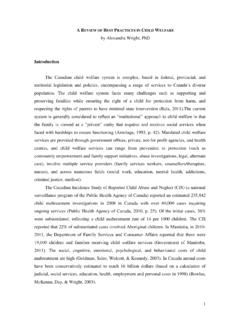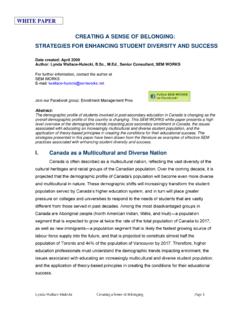Transcription of The Survivors Speak - Truth and Reconciliation …
1 AThe Survivors SpeakA Report of the Truth and Reconciliation Commission of CanadaB Truth & Reconciliation Commission The Survivors SpeakThe Truth and Reconciliation Commission of CanadaThis report is in the public domain. Anyone may, without charge or request for permission, reproduce all or part of this and Reconciliation Commission of CanadaWebsite: and Archives Canada Cataloguing in PublicationTruth and Reconciliation Commission of CanadaThe Survivors Speak : a report of the Truth and Reconciliation Commission of also in French under title: Les survivants s expriment, un rapport de la Commission de v rit et r conci-liation au also on the bibliographical 978-0-660-01985-7 Cat.
2 No.: IR4-5/2015E1. Native peoples--Canada-- residential schools. 2. Native peoples Canada--History. 3. Native peoples--Canada--Social conditions. 4. Native peoples Canada--Government relations. 5. Truth and Reconciliation Commission of Canada. 6. Truth commissions--Canada. I. Title. II. Title: Report of the Truth and Reconciliation Commission of T78 2015 97 C2015-980020-X ContentsPreface .. vIntroduction .. 1 Life before residential school .. 3 Forced departure.
3 13A place of refuge .. 19 The journey .. 23 Arrival .. 31 Language and culture .. 47 Bedwetting .. 59 Daily life .. 63 Strange food .. 69 school meals .. 71 Chores .. 79 Religious training .. 85 Separating siblings .. 91 Gender relations .. 95 Contact with parents .. 99 Fear, loneliness, and emotional neglect .. 109 Despair .. 117 Hiding the Truth .. 119 Classroom experience.
4 121 Regimentation .. 129 Integration into public schools .. 131 Truancy .. 133 Discipline .. 139iv Truth & Reconciliation Commission Abuse .. 153 Student victimization of students .. 165 Medical attention .. 177 Disability .. 183 Warm memories .. 185 Sports and recreation .. 189 Cadets .. 197 Improvements .. 199 The end .. 201 Bibliography .. 205 Endnotes .. 209On June 11, 2008, Prime Minister Stephen Harper issued an apology to the for-mer students of Canada s Indian residential school system , calling it a sad chapter in our history.
5 That chapter is part of a broader story: one in which the Canadian government gained control over Aboriginal land and peoples, disrupted Aboriginal governments and economies, and sought to repress Aboriginal cultures and spiritual practices. The government, often in partnership with the country s major reli-gious bodies, sought to civilize and Christianize, and, ultimately, assimilate Aboriginal people into Canadian society. The deputy minister of Indian Affairs predicted in 1920 that in a century, thanks to the work of these schools, Aboriginal people would cease to exist as an identifiable cultural group in schools were seen as a central element in this project.
6 For their part, Aboriginal people saw the value in schooling. It was at their insistence, for example, that many Treaties required government to provide teachers and establish reserve decision to invest in residential schools was based on a belief that the cultural and spiritual transformation that the govern-ment and churches sought to bring about in Aboriginal people could be most effec-tively accomplished in institutions that broke the bonds between parent and woman with child in carrier basket. 1858. Library and Archives Canada/Credit: Humphrey Lloyd Hime/National Archives of Canada Truth & Reconciliation Commission When Canada was created in 1867, the churches were already operating a small num-ber of boarding schools for Aboriginal people.
7 In the coming years, Roman Catholic and Protestant missionaries established missions and small boarding schools throughout the West. The relationship between the government and the churches was formalized in 1883 when the federal government decided to establish three large residential schools in west-ern to the Indian Affairs annual report for 1930, there were eighty residential schools in operation across the The Indian residential Schools Settlement Agreement of 2006 provided compensation to students who attended 139 residential schools and The federal government has estimated that at least 150,000 First Nation, M tis.
8 And Inuit students passed through these assault on Aboriginal identity usually began the moment the child took the first step across the school s threshold. Braided hair (which often had spiritual significance) was cut, homemade traditional clothing was exchanged for a school uniform, Aboriginal names were replaced with Euro-Canadian ones (and a number), and the freedom of life in their own communities was foregone for the regimen of an institution in which every activity The Roman Catholic mission and residential school in Beauval, Saskatchewan.
9 Descha telets viifrom morning to night was scheduled. Males and females, and siblings, were separated, and, with some exceptions, parental visits were discouraged and and cheaply built schools often had poor or non-existent sanitation and ventila-tion systems. With few infirmaries in which students with contagious diseases could be isolated, epidemics could quickly spread through a school with deadly results. Because schools were funded on a per capita basis, administrators often violated health guide-lines and admitted children who were infected with such deadly and contagious diseases as tuberculosis.
10 Often, parents were not informed if their children became sick, died, or ran the first half of the twentieth century, the schools were on what was termed the half-day system , under which half a day was spent in the classroom and the other half in voca-tional training. For the boys, this was largely restricted to farming and the crafts that a farmer might have need of, while the girls were trained in the domestic sciences. In reality, this was not so much training as child labour, undertaken to subsidize the ongoing oper-ation of the at the Roman Catholic school in Fort George, Qu bec, 1939.
